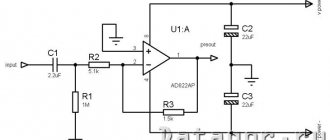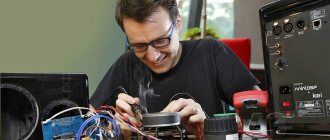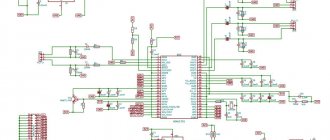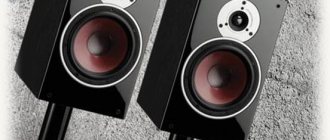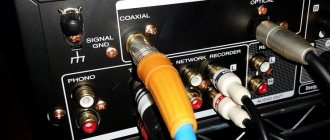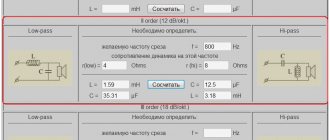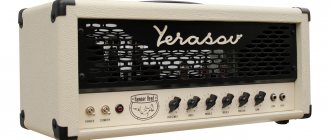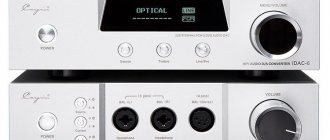$53.68
Check price
(Votes: 2, rating: 4.50 out of 5)
0°
A couple of months ago I started thinking about buying an amplifier for my headphones. They had a painfully creaky sound, despite the high cost. I did everything I could with them, trying to improve the sound, but, unfortunately, nothing helped. I was even going to throw away or give these headphones to some friend, but in time I came across one interesting little thing that very quickly solved the problem. But first things first. It took me a very long time to decide to buy an amplifier, especially from the AliExpress website. It is difficult to choose an expensive product without being able to touch it or check it before purchasing. The decisive role in my choice was played by the price - 3600 rubles for a good (judging by the reviews) DAC. This amount also looks impressive, but if you compare it with the average prices for amplifiers, all questions instantly disappear. In general, I decided to order the FX AUDIO DAC-X6 for $69, because I didn’t have money for anything normal. And now I absolutely do not regret my purchase, although there were quite a lot of problems with it.
Delivery and appearance of the amplifier
First, about the sad things. This device took about two months to reach me, and this does not include shipping. First, the parcel traveled for a long time around China, and then across Russia. As it turned out later, the seller indicated the wrong index, so the courier for a long time could not understand where exactly the amplifier needed to be delivered. There was also a problem with the tracking number. The application indicated that the DAC had already arrived at my post office, but two weeks after its “arrival”, I still had not seen it. I have no idea if this is a problem with the post office or the seller, but both of these options do not suit me.
The equipment is also not enough stars from the sky. The box contained only the DAC itself, the power supply (quite weak, it could have been better placed) and, of course, a standard USB cable (I would write that it is the cheapest of all existing ones, but this is a no brainer). In general, nothing superfluous.
Externally, the device looks very impressive. Brushed polished aluminum body and silver plated bezel. The switch buttons are standard, no frills, but that's to be expected for such a low price. Among the pleasant features are 4 rubberized feet, thanks to which the amplifier does not scratch surfaces. For such a price nothing could be better.
FX-Audio DAC-SQ3: one of the best stationary DACs in the budget segment
Recently, we have become acquainted with a fairly impressive number of stationary DACs for every taste and budget. There weren’t really any budget solutions that could at least somehow compete with the top ones in terms of quality. Today I propose to correct such an oversight and introduce you to the FX-Audio DAC-SQ3. The device is based on the most current chip today, ESS ES9038Q2M, the USB is powered by the proven XMOS XU208, and the LME49720 and preamplifier OPA1656 are responsible for the amplification part. Moreover, these are not all the features of the device. I'll tell you more in this review.
Content
- Characteristics
- Packaging and equipment
- Design/Ergonomics
- Disassembly
- Software
- Measurements
- Sound
- Video version of the review
- conclusions
Characteristics
- DAC: ESS ES9038Q2M
- USB: XMOS XU208
- Amplifiers: LME49720 (replaceable) + 2 x OPA1656
- Audio resolution: up to 384 kHz/32 bit, DSD256
- Frequency range: 20 Hz – 20 kHz
- Inputs: USB
- Outputs: optical, coaxial and linear RCA
- Power: 5 volts 1 amp
- Dimensions: 98 x 122 x 33 mm
- Weight: 278 g.
- OS: Windows, MAC OS, Android, iOS
Packaging and equipment
The DAC arrives in a small cardboard box with the name of the device and the address of the site where you can download various necessary software.
The kit included a set of documentation, a new USB cable (I've never seen one like this before) and a remote control.
The remote control is small in size, all the buttons are rubberized, and it is powered by two AAA batteries. And everything would be fine, but the remote control can only mute the sound and change the digital volume level. That is, the functionality is so-so. But perhaps this is exactly what someone needs.
Design/Ergonomics
The device is made in a classic style with four rubber feet. Surprisingly, there is only one input here - USB. That is, you can connect the DAC to a computer, set-top box, smartphone and anything else that supports this interface.
But as outputs, in addition to the obvious linear RCA, we are also offered digital optics and coaxial. Yes, optics and coaxial are at the output here. Interesting, isn't it? The device, for example, can be used as an intermediate link with some vintage expensive DAC that does not have a USB interface. The device is powered exclusively via USB; no additional units are needed here.
In front we have a large, almost entire front panel, color display indicating the type of stream (PCM/DSD) and the current signal sampling frequency. If you press the buttons up and down, you can see how the signal level numbers run. Why this is needed in a stationary DAC is difficult to understand, but it doesn’t ask for food. I set it to maximum and, as they say, forgot.
During operation, the device heats up a little, it has no background noise, and it takes up almost no space on the table. I used it with my Yamaha HS80M active monitors and Topping L30 headphone amplifier. Tied everything up using Canare RCA cables. Inexpensive, as they say, and a very solid solution.
Disassembly
To disassemble, you need to unscrew all four screws from the back, after which the screen will simply fall into your hands and you can remove the board from the case.
Inside, everything is exactly as promised: ESS ES9038Q2M DAC, XMOS XU208 on USB and three operational amplifiers - a replaceable LME49720 and two soldered OPA1656.
We admired it, if necessary, replaced the LME49720 with something more interesting and put everything back together in reverse order.
Software
Under Windows 10, the DAC was detected automatically for me, thanks to the drivers from the old D01. Already saved many times.
Thanks to them, we get support for older versions of operating systems and the ASIO interface so desired by many. Moreover, it is completely unlocked.
Who doesn’t need all this can have fun using WASAPI Push and Event built into Windows. By default, the system offers quality up to 32-bit 384 kHz.
With iOS and Android devices, the device works with all applications and streaming services. However, as always, the best quality will be in applications that support BitPerfect mode. For example, HiBy or FiiO Music.
Measurements
Based on the measurements, you can only take your hat off to the DAC-SQ3 - it’s simply excellent. All points, with the exception of uneven frequency response, are in “excellent” condition.
The frequency response has a slight attenuation of a quarter decibel at 20 kHz. That is, a completely acceptable deviation. Although this is more likely a question not of the DAC, but of my preamplifier.
The noise, as you can see, is somewhere around minus 130 dB. Dynamic range - 113 dB.
And harmonic and intermodulation distortions are below minus 110 dB. That is, far beyond the limits of human hearing. What can I say, the quality level of the device is literally off the charts. Simply unimaginably cool for such an inexpensive device.
All measurements were made on a MOTU M4 audio interface.
Sound
To evaluate the sound, I decided to compare the device with everything I have on hand from stationary DACs. First came the heavy artillery, in the form of the far expensive SMSL SU-8s. But the way the SU-8s draws textures, in my opinion, is generally unattainable even for devices three times more expensive. So the sound of the DAC-SQ3 does not definitely tear up the tops. But this is, as it were, expected. On the flip side, I decided to compare the review hero with the cheaper FX-Audio DAC X3. The latter turned out to be noticeably simpler in terms of developing timbres and constructing the scene as a whole.
More or less, the DAC-SQ3 clashed only with the Soncoz LA-QXD1, which, wait a minute, is based on the same hardware, but costs almost 2.5 times more. I won’t say, of course, that these are devices of the same level; after all, the Soncoz is noticeably more detailed and sharper, but it’s already somewhere close. And this, for a price gap of more than two times, is definitely a record. In a nutshell, the hero of the review occupies a central position. It doesn’t aim for the upper echelon of DACs, but it does a good job of supporting the middle peasants from below. Which, in my opinion, characterizes the DAC-SQ3 in a very positive way and puts it in the “sounds more expensive than it costs” category.
The general character of the presentation here is a little smoothed out, juicy and quite melodic. Compared to the Soncoz LA-QXD1, it has a little more high frequencies. The bass is clear and textured, the mids are analog-soft, with a pleasant mass, depth and excellent timbre development. The highs are not pushed back here, but also not too accentuated, so as to build a fairly realistic auditory picture and not overplay with brightness and sharpness. Everything is exactly as it should be. Unfortunately, there is no strong emphasis on micro-details and crystal transparency here. The presentation is rather musical with rich, lively images. Why, in terms of musicality, the DAC should be given its due; it plays very emotionally and involvingly. Most of all, it reminded me of the FX-Audio DAC-M1, which we also had in our review, but even there the price tag was a couple of hundred bucks. Here, for a similar class, they ask us only 90 dollars.
Stylistically, the device feels confident in both jazz and heavy music. Of course, it is not particularly suited to anything multi-instrumental or orchestral. There is no proper level of elaboration. But even one instrument here is quite capable of filling the entire musical space, striking in its scale and, so to speak, lyricism. Electronics, blues, soul, ethnic music - everything is played with a bang. Naturally, this directly depends on the quality of the rest of the tract. However, with more or less transparent operation of the amplifier and good quality acoustics, the level of connectivity for its price will be simply amazing.
Such a rich, balanced sound with the ability to slightly tune it in the right direction using a replaceable operational amplifier is wonderful. Once again, this is not the harsh and simplistic sound that we heard in the Aiyima DAC A5 Pro, for example. Rather, on the contrary, here we are already approaching quite serious middle peasants in the person of FX-Audio DAC-M1 and Soncoz LA-QXD1. There is no dryness, detachment or cold neutrality here either. The hero of the review rather has a bias towards melody and timbre richness.
Video version of the review
conclusions
Overall, the FX-Audio DAC-SQ3 DAC surprised me very pleasantly: an excellent large screen, a remote control, USB power (without additional units) and in addition to the classic RCA, there are also two digital outputs, in the form of optics and coaxial. This is, frankly speaking, a good deal for its price. Well, the fact that all the measurements here are “excellent” and the filling is at the level of 200-dollar devices is generally, in my opinion, amazing. Well, one cannot help but note the juicy, rich sound. With excellent, for its class, rendering of textures, expressiveness and conveyance of emotions. Simply an excellent DAC at an almost bargain price. I personally have never seen anything better in the sub-$100 segment. FX-Audio are great guys, and the device is definitely a thing. Feel free to take it.
CHECK CURRENT PRICE FOR FX-Audio DAC-SQ3
This DAC is currently available with promotional codes HIFICOLLEGE2 and HIFICOLLEGE8 , giving an additional discount of $7.20.
Functionality and connection speed
The DAC has all standard connectors for connection and operation. You just need to connect it to your computer and enjoy the sound quality. There is no need to install drivers on Win10 (Win7 and Win8 are a little more complicated, but everything is installed pretty quickly). In general, there are only advantages to the connection. Now let's talk about sound.
Let me say right away that there is no point in expecting stunning sound from this device. FX AUDIO DAC-X6 is an entry-level DAC and shows mediocre results in working with sound. No, that doesn't mean he's bad. If you pay attention to the price, everything will become clear, because even the worst amplifiers (much worse than the FX AUDIO DAC-X6) cost an order of magnitude more. In principle, it improves the sound and this is really noticeable, because squeaks and various noises disappear and the bass increases, but there is no particular depth. Unless you listen for a long time and get used to the sound. But I’m not that much of a music lover, so I’ll give it a minus for the depth.
In general, the device turned out to be good and compact. It's nice to know that money isn't wasted. It does perform better than the built-in sound chip, but that doesn't mean all the noise will disappear and depth will appear.
Digital audio processor FX-AUDIO D802J: Japanese exotic
True audiophiles usually have a disdainful attitude towards digital technologies, which, however, does not prevent them from using the achievements of progress - for example, FLAC or APE formats. But the mere mention of a digital power amplifier can cause a storm of indignation on specialized forums. However, there is no evidence that, when properly implemented, class D amplifiers are a priori inferior to classic analog solutions of classes A and AB. In the Land of the Rising Sun, an interesting new product directly related to this topic has appeared on sale.
The compact universal device released by FX-AUDIO under the name D802J is not an amplifier in the usual sense of the word. This is rather the embodiment of ideas about a complete digital path, where the analog link is only speakers or headphones. The D802J costs only ¥11,800, that is, about $116. The heart of this amplifier is the STMicroelectronics STA326 chip - a comprehensive solution that includes not only the function of enhancing low frequencies. Let's start with the fact that the chip itself can operate in different modes: single-channel with an output power of 160 watts, two-channel with a power of 80 watts per channel and three-channel, when 40 watts of power per channel is reserved for the stereo pair and another 80 watts are supplied to the subwoofer.
The sound processor, which is what the STA326 should be called, has many features: a digital equalizer with 28-bit processing, separate control of low and high frequencies, automatic volume adjustment, saving custom volume curves and equalizer settings, a radio interference suppression system and a number of others. Internal audio processing is carried out in 96 KHz mode with a resolution of 24‒28 bits. The input interface of the chip is standard, I2S. It supports sampling rates from 32 to 192 KHz. The Asahi Kasei AKM4113 chip is used as a receiver. The proprietary STM DDX amplifier, with the correct hardware implementation, easily provides 100 dB or more signal-to-noise ratio. The dynamic range is the same 100 dB or more. These are excellent performance for a device at this price.
In the D802J, the amplifier operates in dual-channel mode, powered by any external power supply that provides direct current with a voltage of 12 to 32 volts. The maximum output power depends on the voltage. The main interface is USB, but there are also S/PDIF inputs - coaxial and optical. The D802J is capable of working in conjunction with a PC, even in the environment of such ancient operating systems as Windows 98SE or MacOS 9. The dimensions of the device are only 117 × 206 × 35 millimeters: this is just a gift for those who cannot afford a full-size audio rack. And we will take the liberty to say that for all its compactness and completely digital nature, according to the characteristics of the D802J it can be classified as a Hi-Fi class device.
Filling
Aluminium case:
Main board:
It’s at the back: The board is closer:
S/PDIF converter USB 2.0 decoder Operational amplifier (can be changed, it’s in the crib) Power supply noted But the main pearl is rich polished quartz 12.288 MHz.
Measurements
Windows 10 is detected by USB:
Supported modes:
RMAA measurements Linear output:
Headphone output: Galvanically isolated optics - the measurement results will be even better. There is no permanent exit.

